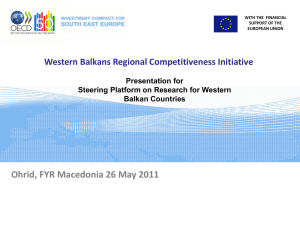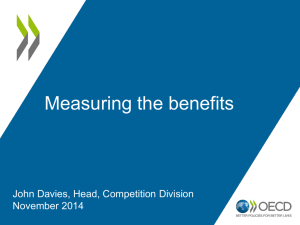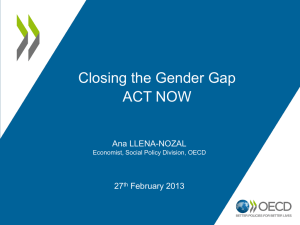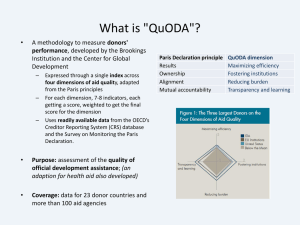SEE 2020 Monitoring
advertisement
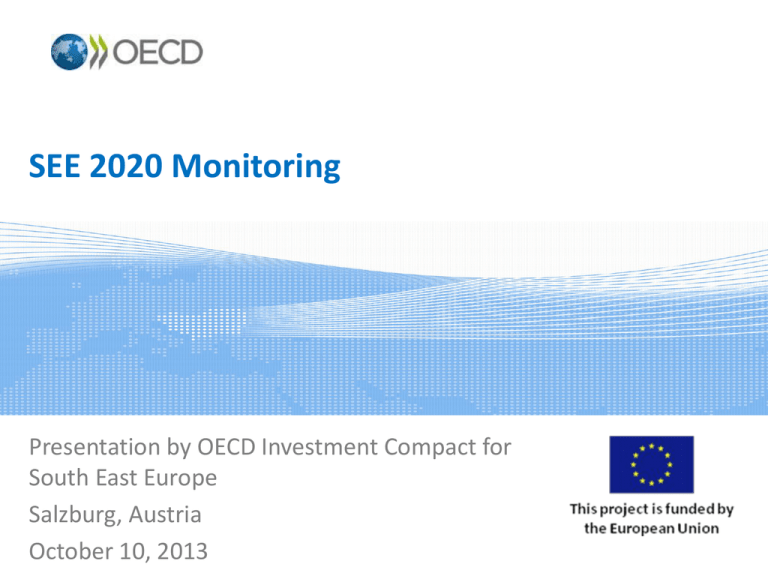
SEE 2020 Monitoring Presentation by OECD Investment Compact for South East Europe Salzburg, Austria October 10, 2013 The OECD Investment Compact for SEE contributes to both monitoring and implementation of the SEE2020 strategy SEE 2020 i. Increase regional GDP PPP per capita from 38% to 46% of the EU-27 average ii. Grow the region’s total value of trade in goods and services by more than 130% iii. Reduce the region’s trade deficit from 14.1 to 11.6 percent of regional GDP Pillar Integrated growth Pillar iv. Increase intra-regional targets trade in goods by more than 230% v. Increase overall FDI inflows to the region by at leas t 120% Smart growth Sustainable growth Inclusive growth vi . Increase GDP per person employed by 33%; vii. Add 300,000 highly educated people to the region's workforce vii. Increase the rate of enterprise creation by 20% ix. Increase exports of goods&services per capita from the region by 130% x. Increase the xi . Increase government overall effectivenes s by 20% by employment from 2020 40.2% to 45.2% Pillar Free Competiti Integrati Human R&D and Digital Culture Resource Competiti Employ Health on into Capital Innovatio Society and efficiency veness ment dimen Trade ve Develop n Creative sions Area Economic the Environm Global ment ent Economy Governance for growth Effective AntiJustice public corrupti services on Sectors SEE 2020 Monitoring Sector competitiveness 2 The monitoring component builds on a tradition of assessment of investment climate in SEE 2005 2006 4th SEE ministerial in Sofia, Bulgaria, 10 June 5th SEE ministerial in Vienna, Austria on 27 June Ministers agree on the need for a regional framework for investment consistent with EU principles and inspired by the OECD Policy Framework for Investment. Ministers endorse a “Regional framework on Investment” Completion of first Investment Reform Index 2010 2nd Investment Reform Index released 2011 2012 2013 6th SEE Ministerial 7th SEE Ministerial 8th SEE Ministerial SEE 2020 Endorsement Endorsement Vision based of SEE 2020 of SEE 2020 on five pillars headline Strategy (integrated, targets smart, Greater time and staff commitment sustainable, inclusive and governance for growth 3 Monitoring structure Follow the SEE 2020 Strategy, including its pillars and dimensions Assess policies used to implement the SEE 2020 Strategy, based on tools developed by the OECD • Regional Framework for Investment (IRI) • Product-Market Regulation, • Labour Market Regulation, • Services Trade Restrictiveness Index, • Government at a Glance, • Education at a Glance, • Innovation Strategy Track progress on the achievement of overall progress on the Strategy, including but not limited to the headline targets Implementation of monitoring through a tripartite assessment Regional organisations Government selfassessment Private Sector Independent experts 5 Monitoring framework (illustrative) Pillars Integrated Smart Sustainable Indicators Dimensions D. Human Capital Development 1. Quality, qualifications and mobility 2. Inclusiveness and lifelong learning Inclusive 3. Entrepreneurial learning Governance for growth E. R&D and innovation F. Digital Society G. Culture & Creative sectors Policy Impact/ Outcome Qualitative Quantitative National policy approach to widen participation in higher education Participation in education and training by educational level and gender Development and implementation of work-related system of continuing education and training 6 Educational attainment by educational level Drop-out rates by educational institution Monitoring framework (illustrative) Pillars Integrated Smart Sustainable Indicators Dimensions D. Human Capital Development 1. Quality, qualifications and mobility 2. Inclusiveness and lifelong learning Inclusive 3. Entrepreneurial learning Governance for growth E. R&D and innovation F. Digital Society G. Culture & Creative sectors Policy Impact/ Outcome 1. No CET strategy exists. Qualitative National policy approach to widen participation in higher education Development and implementation of work-related system of continuing education and training Quantitative 2. A CET Strategy is being drafted. Participation in Reduce early 3. CET strategy adopted, basedfrom on input education and leavers from relevant public and private sector training (25-64 education and institutions and civil society. The year olds) training strategy includes indicators of success, an action plan, allocated budgets and Increase resources to monitor the strategy’s implementation. tertiary educational 4. Level 3 + Evidence ofattainment strategy as implementation, with targeted support % of measures, linkages to the national population qualification framework, and wide dissemination of information on CET programmes. 5. Level 4+ Strategy implementation occurs with a high quality of programme delivery. Information gathered is used to 7 Regular private sector improve policy. consultation. Next Generation Competitiveness Initiative: Monitoring component output (example from IRI 2010) Human capital development 5 4 Score 3 2 1 0 ALB BIH BG HRV XK Dimension average (weighted) : human capital development MK MD MNE Continuing education and training Vocational education and training 8 Source: OECD Investment Reform Index 2010 RO SRB Next Generation Competitiveness Initiative: Monitoring component output (example from IRI 2010) Workforce skills strategy: design and evidence ALB BIH BG HRV XK MK MD MNE RO SRB 1.00 1.00 4.00 3.00 1.00 4.00 3.00 4.00 4.00 3.00 The inclusiveness of strategy formulation 3.00 2.00 4.00 3.00 2.00 3.50 3.00 4.00 5.00 4.00 Subdimension average: strategy formulation 2.00 1.50 4.00 3.00 1.50 3.75 3.00 4.00 4.50 3.50 Teacher recruitment and retention 3.50 2.00 3.00 2.50 3.00 3.50 3.00 1.00 3.00 2.00 Development of the teacher 4.00 2.00 4.00 3.00 3.00 4.00 2.50 3.00 4.00 4.00 Subdimension average: inputs to initial education 3.75 2.00 3.50 2.75 3.00 3.75 2.75 2.00 3.50 3.00 Development of the VET system 3.50 3.00 3.50 3.00 3.00 4.00 4.00 3.00 5.00 3.00 Consultative processes in the VET 3.00 3.00 4.00 4.00 3.00 4.00 3.00 4.00 5.00 3.00 3.25 3.00 3.75 3.50 3.00 4.00 3.50 3.50 5.00 3.00 1.00 2.00 3.00 3.00 1.00 2.50 3.00 3.00 4.00 2.00 Dimension average (simple): human captial development 2.50 2.13 3.56 3.06 2.13 3.50 3.06 3.13 4.25 2.88 Dimension average (weighted) : human capital development 2.68 2.17 3.51 3.03 2.28 3.50 3.03 2.91 4.14 2.83 Strategy formulation Inputs to initial education workforce Vocational education and system training Subdimension average: vocational education and training Extent of development of workContinuing education and related system of continuing training education and training 9 Source: OECD Investment Reform Index 2010 SEE2020 Strategy Monitoring: Timeline 2013 Q3 Jan: Consult grid with contact points from reg. org’s 2014 May: Missions to working meetings of reg. org’s completed 2015 Sept.: Grid distributed to reg. org’s Jan: Filled grids received from contact points of reg. org’s 2016 Q2 Sept: 1st analysis completed June: Release of “SEE Outlook” SEE ministerial Nov-Dec: In-house feedback on grid July: OECD work on grids starts June: Feedback on grids from governments received Febr-Mar: Grids filled by local independent experts and private sector representatives Oct: Review meetings with reg. org’s, their country contact points and local experts (4 meetings) Jan: Final review meetings with reg. org’s and their country contact points (4 meetings) Thank you for your attention. Alan Paic Head OECD Investment Compact for SEE Organisation for Economic Co-operation and Development (OECD) 11


